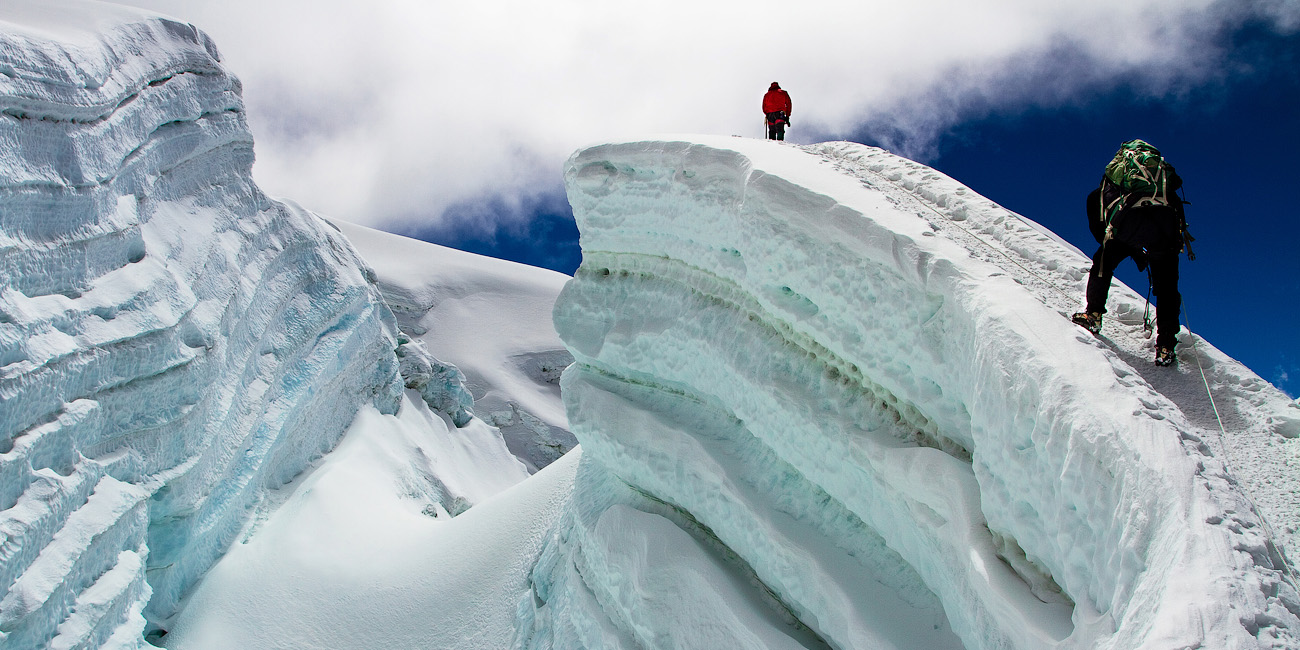
I’ve never had a normal job, never worked in an office, never had to wait for a vacation leave. From teenage years on I’ve always practiced sports so on turning 18 I signed a contract with a sports club. All I had to do was to keep in a good shape and give a good performance in competitions. I had a lot of freedom and curiosity. Once when I was on holiday in Kislovodsk I went on a trip in the pre-Elbrus area with elevation to mount Cheget. The route is quite popular with mountain trekkers. Unforgettable views. Soon after that trip I came back to the Caucasus – at first for three weeks, then for a month, then I left the sports club completely. Four years later I went to live in the Himalayas for a longer period.
There are few things one can do in the mountains when one is completely alone — one can walk, meditate, look around and take pictures. I once tried not to bring the camera along – just once. Because I really want to show to the others what I see when I leave home. This is expedition photography – it is very difficult to get, and that’s what is so valuable about it. There are very few people who take pictures in the Himalayas and those who go to the highlands can be counted by the fingers of one’s palm.
{ “img”: “/wp-content/uploads/2015/01/nepal_09.jpg”, “text”:”The Elbrus elevation.” },
{ “img”: “/wp-content/uploads/2015/01/nepal_10.jpg”, “text”:”The Elbrus elevation.” },
{ “img”: “/wp-content/uploads/2015/01/nepal_11.jpg”, “text”:”The Himalaya. View of Tilicho lake from Mesokanto-La pass. ” },
{ “img”: “/wp-content/uploads/2015/01/nepal_12.jpg”, “text”:”Nepal. Sugarmatha national park. Pumori. Spring 2013.” },
{ “img”: “/wp-content/uploads/2015/01/nepal_13.jpg”, “text”:”Nepal. Sugarmatha national park. Pumori. Spring 2013.” },
{ “img”: “/wp-content/uploads/2015/01/nepal_14.jpg”, “text”:”India. Ladakh. Lamayuru monastery. Summer 2012.” }
Sometimes I guide groups. There are different kinds of treks and many picturesque mountain places are fairly easy for tourists for get to. In relatively comfortable conditions – with no sleeps in tents and with normal food provided – one can see very beautiful mountains. But when I am by myself, I tend to go further away because I seek calmness and quiet and the feeling of total aloneness, separation from the rest of the world.
I love the Caucasus and go there almost every year. But the Himalaya is really the place where I feel like home. As I explore those mountains I go further and further, each time taking a more difficult and untrodden path, every time I leave for a longer period. I always make my own routes. In my backpack behind my back I normally carry warm clothes, gas, a burner, a tent and a sleeping bag, in the backpack that I carry up front there’s a camera, a tripod, filters and a couple of lenses. In total 30-35 kg.
At 5000 meters over the sea the winter is eternal, there are glaciers, snow and rocks. During the day the average temperature is +15°C, at night, depending on the season, as low as -25°C. Shooting time is limited to an hour at sunrise and another hour at sunset. But I prefer to shoot at night: stars and mountains – those are the most beautiful phenomena a human eye can see.
From the spot where car road finishes to the shooting place it’s something like 3 or 4 days trekking. At first you follow popular tourist trails with huts and normal food along the way. Then civilisation is left behind and there are just lonely mountains ahead.
Once at Mesokanto pass, close to Tilicho lake, the weather suddenly turned nasty: the visibility was very poor, It was snowing and raining at the same time. I spent three days in a tent. I was lucky the bad weather didn’t last longer, so I didn’t get blown off by the wind. When you are all by yourself in a place that, you can only rely on yourself. That wakes up a feeling of incredible consciousness and purity of perception. And it is very dear to me, so I tend to go away in the mountains by myself more and more often.
{ “img”: “/wp-content/uploads/2015/01/nepal_03.jpg”, “text”:”A woman is doing a traditional Buddhist rite – sacred circular walk (usually performed clockwise around a mountain or a monastery) at Mt Kailash.” },
{ “img”: “/wp-content/uploads/2015/01/nepal_04.jpg”, “text”:”Tsum valley. Mu Gompa.” },
{ “img”: “/wp-content/uploads/2015/01/nepal_05.jpg”, “text”:”Girls in national clothes near Kailash.” },
{ “img”: “/wp-content/uploads/2015/01/nepal_06.jpg”, “text”:”Langtang. Nepal.” },
{ “img”: “/wp-content/uploads/2015/01/nepal_07.jpg”, “text”:”Tsum valley. Nepal.” },
{ “img”: “/wp-content/uploads/2015/01/nepal_08.jpg”, “text”:”People looking at flames. Varanasi. India. ” }
In the west Nepal, on the border with Tibet, tourists are very rare. There are some villages there where people have never heard English, have never ever seen a white person. People there would be less surprised to see an alien than a person with backpacks and a camera.
Mountain people are kind, welcoming and generous in spite of poverty and crudeness of their own existence. In the mountains you can’t deny a stranger warmth, food and a place to spend the night. No matter who you are those people will share everything they have because they know what kind of hardships you are going through.
Better-off Nepalese go away from those mountain settlements, build houses in valleys. Everyone’s dream is to have a house in the Kathmandu valley. But even after they build it, they come back to the mountains for the summer. Because the mountains are in their bloodstream.
Ethnographers think that people who live up in the mountains found themselves there because at the time of land redistribution and tribal wars they were not inclined to fight. So they went further and further back until they got to places where no one but them could survive. Those people can breed sheep and goats, but they are no warriors. Time has stopped for them, their lifestyle hasn’t changed in one thousand years.
{ “img”: “/wp-content/uploads/2015/01/nepal_01.jpg”, “text”:”” },
{ “img”: “/wp-content/uploads/2015/01/nepal_02.jpg”, “text”:”National park Sagarmatha. The way across three passes. ” }
When you spend a lot of time travelling with people you don’t know anything about, you get tolerant, flexible and easily get used to everything life has in stock for you: this is good, but that is not bad either. Sometimes I stay in West Nepal for a month, sometimes longer, hiking in the mountains and living in mountain villages. I am now planning to go there for at least two months: I am going to do a photo project about life in distant mountain villages.
I am interested in contrasts: it is nice to come back to the civilised world, but it is also good to leave it for a distant wilderness. If it is Kathmandu you are going back to, the change is not so dramatic: the Nepalese are calm and nice people. But coming back to Russia is always difficult: I hadn’t been to Moscow for a year, came back and had to deal with a lot of negative stuff, a lot of hostility. The level of life of Muscovites is a few times higher than that of the Nepalese, but the difference in the acceptance of life between the two is really striking.
I got interested in traditions and philosophy of people in this part of the world even before I fell in love with the mountains. In February I am planning to do another Vipassana – a 10-day mediation practice during which you give a vow not to speak and you keep it. You meditate for 10 hours a day, eat moderately, give up all kinds of entertainments, harmful habits and try to cut out communication with humans as well you can. It looks like it is very difficult to carry out all requirements of this practice, but in India it is a very natural thing to do. And when I am by myself, in the mountains, it is even easier to do meditation. Because you don’t have to sit still staring at a wall or singing mantras: you can walk, you can take pictures. High up in the mountains there is no rush, nothing distracts you from looking at the mountains and studying yourself. This is an expedition and meditation all in one.
{ “img”: “/wp-content/uploads/2015/01/nepal_15.jpg”, “text”:”Shiva temple on Gosaikunda lake. Langtang. Nepal.” },
{ “img”: “/wp-content/uploads/2015/01/nepal_16.jpg”, “text”:”Nepal. Manang. Autumn 2013.” },
{ “img”: “/wp-content/uploads/2015/01/nepal_17.jpg”, “text”:”India. Ladakh. Lamayuru. Summer 2012.” },
{ “img”: “/wp-content/uploads/2015/01/nepal_18.jpg”, “text”:”Nepal. National park Sagarmatha. Ama Dablam. Spring 2013.” },
{ “img”: “/wp-content/uploads/2015/01/nepal_19.jpg”, “text”:”India. The Spiti valley. Key monastery. 2012.” },
{ “img”: “/wp-content/uploads/2015/01/nepal_20.jpg”, “text”:”Nepal.” },
{ “img”: “/wp-content/uploads/2015/01/nepal_21.jpg”, “text”:”National park Sagarmatha. The way across three passes.” },
{ “img”: “/wp-content/uploads/2015/01/nepal_22.jpg”, “text”:”Elevating Mt Elbrus.” }





